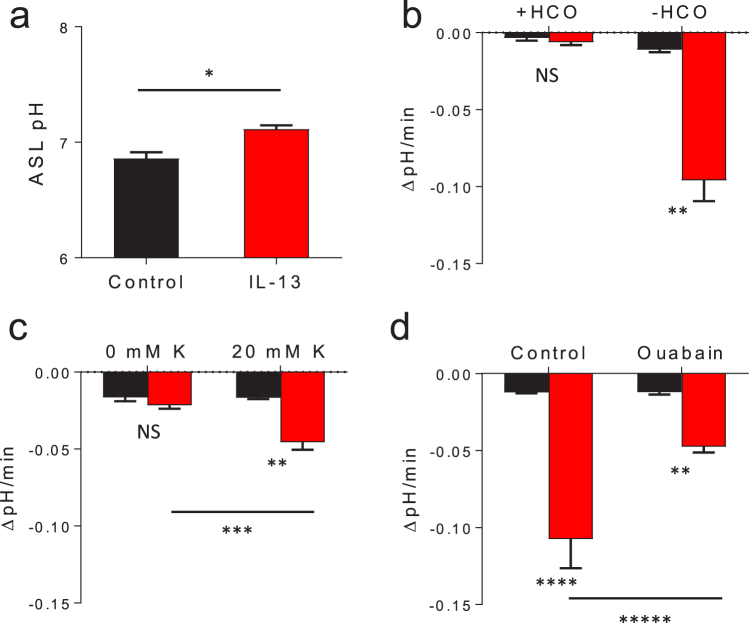Figure 5.
IL-13 increases apical proton secretion. Differentiated HBE cells were cultured ± IL-13, the ASL was labeled with 10 µL BCECF. The cells were incubated in the presence or absence of HCO3− as indicated. Control conditions are represented in black, IL-13 treated conditions are represented in red for all plots. (a) IL-13 leads to a marginal increase in steady state ASL pH. Following the addition of BCECF, the cells were maintained in solution containing 25 mM HCO3− and gassed with 5% CO2 at 37 °C. The ASL pH was measured 4 h later. Data shown are mean ASL pH ± IL-13, n = 12 experimental replicates from 3 tissue donors, each replicate with 4 averaged pH readings, *p = 0.0006 by unpaired Student’s t-test. (b–d) A 10 µL bolus of BCECF in an alkaline solution (pH 7.5) was added to the apical surface of HBE ± IL-13. The rate of ASL pH change was measured over 10 min. (b) IL-13 increases the ASL acidification rate in HBE cells in the absence of HCO3−. Data shown represents mean rate of ASL pH change ± SEM (ΔpH/min) from 9 culture filters from 3 tissue donors, **p < 0.0001 by unpaired Student’s t-test. (c) IL-13 driven proton secretion is potassium dependent. The apical surface was rinsed with 0 mM K+ or 20 mM K+ prior to pH measurements. Data represents mean rate of ASL pH change ± SEM (ΔpH/min) from 12 replicates from 3 tissue donors, **p < 0.0001 by unpaired Student’s t-test and **p = 0.0002 by paired Student’s t-test. (d) IL-13 mediated increases in apical proton secretion is sensitive to apical ouabain. Rate of ASL pH change was measured in HBE cells cultures ± IL-13 after the addition of a 10 µL bolus of an alkaline solution (pH 7.5). The filters were then rinsed thoroughly and a second 10 µL alkaline bolus with 50 µM apical ouabain was added and the rate of ASL pH change was measured. Data shown represents mean rate of ASL pH change ± SEM (ΔpH/min) from 6 culture filters from 2 tissue donors, ****p = 0.0005 and *p < 0.0001 by unpaired Student’s t-test and *****p = 0.0175 by paired Student’s t-test.

